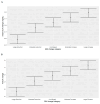Non-Interventional Weight Changes Are Associated with Alterations in Serum Uric Acid Levels
- PMID: 38673586
- PMCID: PMC11051435
- DOI: 10.3390/jcm13082314
Non-Interventional Weight Changes Are Associated with Alterations in Serum Uric Acid Levels
Abstract
Background/Objectives: Serum uric acid is an established cardiovascular risk factor. Higher serum uric acid levels are associated with overweight and obesity. We assessed whether non-interventional weight changes affect serum uric acid levels. Methods: We performed a retrospective analysis of 19,193 participants referred to annual medical screening. Body mass index (BMI) and serum uric acid were measured annually. Subjects were divided into five groups according to changes in BMI between visits: large reduction (reduction of more than 5% in BMI), moderate reduction (reduction of more than 2.5% and 5% or less in BMI), unchanged (up to 2.5% change in BMI), moderate increase (increase of more than 2.5% and 5% or less in BMI), and large increase (increase of more than 5% in BMI). The primary outcome was serum uric acid level changes between visits. Results: A decrease in serum uric acid levels was evident as BMI decreased and an increase in serum uric acid levels was associated with an increase in BMI. The proportion of patients whose serum uric acid levels were increased by at least 10% between visits increased with the relative increase in BMI, while the proportion of patients whose serum uric acid levels were reduced by at least 10% decreased with the relative decrease in BMI. Conclusions: Non-interventional weight changes, even modest, are associated with significant alterations in serum uric acid levels. Our findings may aid in better risk stratification and the primary prevention of cardiovascular morbidity and mortality.
Keywords: BMI; body mass index; uric acid; weight changes.
Conflict of interest statement
The authors declare no conflicts of interest.
Figures



Similar articles
-
Non-Interventional Weight Changes Are Associated with Alterations in Lipid Profiles and in the Triglyceride-to-HDL Cholesterol Ratio.Nutrients. 2024 Feb 8;16(4):486. doi: 10.3390/nu16040486. Nutrients. 2024. PMID: 38398811 Free PMC article.
-
Non-interventional weight changes affect systolic blood pressure in normotensive individuals.J Clin Hypertens (Greenwich). 2021 May;23(5):990-998. doi: 10.1111/jch.14228. Epub 2021 Mar 6. J Clin Hypertens (Greenwich). 2021. PMID: 33675167 Free PMC article.
-
Influence of body size on urinary stone composition in men and women.Urol Res. 2006 Jun;34(3):193-9. doi: 10.1007/s00240-006-0042-8. Epub 2006 Feb 11. Urol Res. 2006. PMID: 16474948
-
Higher Body Mass Index, Uric Acid Levels, and Lower Cholesterol Levels are Associated with Greater Weight Loss.Endocr Metab Immune Disord Drug Targets. 2020;20(8):1268-1281. doi: 10.2174/1871530320666200429235830. Endocr Metab Immune Disord Drug Targets. 2020. PMID: 32351190
-
Benefits of sustained moderate weight loss in obesity.Nutr Metab Cardiovasc Dis. 2001 Dec;11(6):401-6. Nutr Metab Cardiovasc Dis. 2001. PMID: 12055705 Review.
Cited by
-
Association between life's essential 8 and hyperuricemia among adults in the United States: insights from NHANES 2005-2018.Front Med (Lausanne). 2024 Nov 6;11:1455164. doi: 10.3389/fmed.2024.1455164. eCollection 2024. Front Med (Lausanne). 2024. PMID: 39568733 Free PMC article.
-
Association of Body Mass Index with Echocardiographic Parameters and Incidence of Left Atrial Thrombus or Spontaneous Echo Contrast in Patients with Nonvalvular Atrial Fibrillation: A Cross-Sectional Study.Rev Cardiovasc Med. 2024 Dec 31;26(1):26014. doi: 10.31083/RCM26014. eCollection 2025 Jan. Rev Cardiovasc Med. 2024. PMID: 39867203 Free PMC article.
References
-
- Reis J.P., Allen N., Gunderson E.P., Lee J.M., Lewis C.E., Loria C.M., Powell-Wiley T.M., Rana J.S., Sidney S., Wei G., et al. Excess Body Mass Index- and Waist Circumference-Years and Incident Cardiovascular Disease: The CARDIA Study. Obesity. 2015;23:879–885. doi: 10.1002/oby.21023. - DOI - PMC - PubMed
-
- Powell-Wiley T.M., Poirier P., Burke L.E., Després J.-P., Gordon-Larsen P., Lavie C.J., Lear S.A., Ndumele C.E., Neeland I.J., Sanders P., et al. Obesity and Cardiovascular Disease: A Scientific Statement From the American Heart Association. Circulation. 2021;143:e984–e1010. doi: 10.1161/CIR.0000000000000973. - DOI - PMC - PubMed
-
- Global Burden of Metabolic Risk Factors for Chronic Diseases Collaboration (BMI Mediated Effects) Lu Y., Hajifathalian K., Ezzati M., Woodward M., Rimm E.B., Danaei G. Metabolic Mediators of the Effects of Body-Mass Index, Overweight, and Obesity on Coronary Heart Disease and Stroke: A Pooled Analysis of 97 Prospective Cohorts with 1·8 Million Participants. Lancet. 2014;383:970–983. doi: 10.1016/S0140-6736(13)61836-X. - DOI - PMC - PubMed
LinkOut - more resources
Full Text Sources

